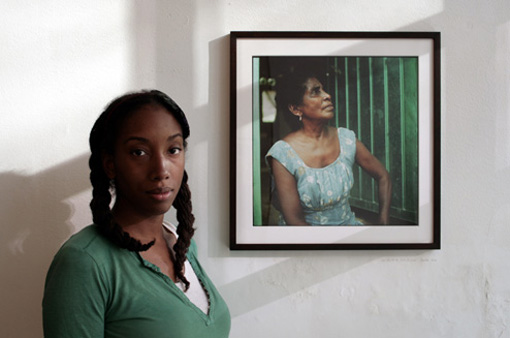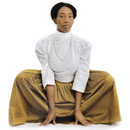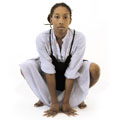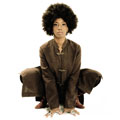
| |

Photo: Dorina Hecht ©Galerie Peter Herrmann
|
| |
(©2008) Known for approaching her subjects in a manner that is equal parts personal, technical, and intense, Ayana V. Jackson's images provide viewers with a compelling glimpse of a human condition that overflows borders.
At first glance the images appear to be simple reproductions of everyday moments or snapshots, but they are more than pure mimetic expressions. Charles Cooley, whose sociological approach was formative for the artist, suggests that we develop our idea and organization of our self through the eyes of others, the Looking Glass Self.
Ayana V. Jackson is defining her work as an exploration of the individuals interaction with society. She says: At the same time that I capture individuals in their own space surrounded by their own environment, my choice of one person/image over another is based on my ability to find visual indicators of shared experience and common influences. In this way the images reflect a transnational or borderless community to which I feel a member.
So in a sense she is implicit in the images, like two sides of a medal; interdigitating. The varied forms of representing Self are in conversation with each other. In portraiture, Attire/Costume, posture/pose, and environment/backdrop work as broadcasting signals, or codes to be interpreted.
Some images reference African American portraiture from the early and mid 20th century where the preoccupations of an aspiring class are made visible in the image composition. Others present visual indicators of the transcendent nature of hip hop and globalized youth culture.
By overexposing her film her images take on the impression of another time affording them a strange dramaturgy consistent with the portraiture of studio photographers James Van der Zee and Malick Sidibé despite the fact that Jackson displays her protagonists in their own space.
In a series of single portraits, which reference The Thinker, Ayana V. Jackson concentrates on faces, gestures and activities as well as on individual charisma. Her protagonists are talking through pictures and the dialog of the Looking-Glass Self takes place between the artist and the portrayed person.
|
 |
| Looking Glass Self | 2008 |
 |
|
|
|
|
 |
|
Accrochage:
Juil 24, - October 1, 2011
©Our cooperation with African American artist Ayana V. Jackson began in 2005, when Jackson spent some time in Berlin studying with Katharina Sieverding at the University of the Arts. That year, we included her photographic research on hip-hop, Full Circle Series 1, in our Visualized Rhythms – Music in African Visual Art exhibition. Since her 2008 solo show, Looking Glass Self, she’s become a well-known fixture in the gallery program. Since that first show, we’ve shown Jackson’s work in various group exhibitions, most recently at Focus 11 in Basel.
The artist, who currently lives in Johannesburg, plunged into the world of African art and artists while conducting sociological photographic research. But at the latest since participating in the Photography Biennial in Bamako, she’s become an integral element of the new continental caravan. If at the beginning Jackson’s work still retained a distinctly documentary character, it has evolved steadily since the Black Madonna series as the artist moves more and more towards photographic staging – as, for example, in the new Leapfrog series that we’re now exhibiting.
The work consists of a series of photographs along with a video, which we will present to you in our upcoming Video Weeks. The photographs trace, in ten stages, the evolution story of the African woman since pre-colonial times and jump chronologically from one generation to the next. Inspired by the self-portraits of Claude Cahun and Samuel Fosso, Jackson uses herself as the model, who carries within her a little piece of all the time periods represented in the work – "a bit of the other." The artist portrays archetypes in the pictures, beginning in a traditional African context then moving more and more towards the diaspora and landing, eventually, in the globalized modern era. Dressed in the fashions of the respective epochs, she presents herself in colonial times and in the Enlightenment, as part of the abolitionist movement, the African independence movement, the civil rights movement and the Harlem Renaissance, arriving, at last, at the post-black and afrofuturist present. Taken together, the images constitute the Grand Matron Army, which represents the principle of memory.
The leapfrog arrangement references several mythologies, particularly those related to fertility, while also fcuntioning metaphorically. The kinetic aspect of the stance – i.e. the impending jump – calls to mind a mother’s commitment to seeing beyond barriers in an effort to seek opportunities for the next generation. At the same time, the position brings sexuality into the matter and asks the viewer to question the role of desire and objectification in class mobility.
The work was produced in consideration of the scholarship of Paul Gilroy and Stuart Hall and inspired by photographers Katherina Sieverding, Samuel Fosso and Claude Cahun. Production was made possible with the help of Natacha Bernette (makeup artist), Tamara Faniot (stylist), Sarah Bernstien (photographer), Andreas Vlachakis (photographer), David Tlale (designer) and Feisel D (makeup artist and stylist). The video was produced in collaboration with the artist Pascale Obolo. |
| |
 |
|
|
| |
 |
|
|
 |
 |
|
|
 |
| |
 |
African by Legacy - Mexican by Birth
Ayana V. Jackson & Marco Villalobos
Catalog. 2006. Paperback. English. 76 pages.
35 Euro
|
| Cooperations with Galerie Peter Herrmann |
| |
Visualised Rhythms
July 8 - August 20, 2005
in coop. w. Galerie im Waschhaus and Afrika Festival Potsdam
Jürgen Schadeberg, Sokari Douglas Camp, Owusu-Ankomah, Ayana Vellissia Jackson, Sonja Kandels, Nzante Spee, Aboudramane |

|
| |
Focus 10pdf
Basel (off art Basel). June 15 - 18, 2011.
The Leapfrog - Grand Matron Series
With: Aboudramane, Nirveda Alleck, Steve Bandoma, Jan-Henri Booyens, Ntando Cele, Ato Malinda, Nathalie Mba Bikoro, Mohau Modisakeng, Rowan Pybus, Youssef Tabti, Fabrice Temagna Wamba and Graeme Williams. Galleries: doual'art, Galerie Peter Herrmann, Galerie Imane Farès and Strip of Gaza |

|

|

